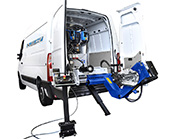TPMS, Tire Pressure Monitoring System is an electronic system designed to monitor the air pressure inside the tires.
The European Commission has decided (with 661/2009 regulation) that all new vehicles intended for passenger transport approved since November 1, 2012, must be equipped with tire pressure monitoring systems. For models already on the market and approved prior to November 1, 2012, TPMS will be mandatory as of November 1, 2014; from that date all passenger vehicles must be equipped with TPMS system.
The US government, through the National Highway Traffic Safety Administration, requires that all cars, light trucks and vans must be equipped with TPMS starting from year 2008. Due to the transitional regime of requirements, 20% of cars and light vehicles manufactured in 2006 and 70% of those manufactured in 2007 are already equipped with the TPMS.
This important news should be well understood by those who have to deal with tires every day, especially car drivers and tire service professionals.
How does TPMS work?
There are two different types of system used today: Direct TPMS and Indirect TPMS.
- Direct TPMS uses a pressure sensor mounted inside each wheel and constantly measures the air pressure. When air pressure drops 25% or more below the manufacturer's recommended level, the sensor transmits information to the vehicle's electronic control unit and the tire pressure warning light appears on the cockpit.
- Indirect TPMS works with Antilock Braking System (ABS) and electronic stability program (ESP). If the tire pressure is low, the rotational speed of the wheel will be different than the other tires. This information is detected by the car's computer system, which triggers the dashboard indicator light.
What information is transmitted by direct TPMS to a vehicle's on-board electronic control unit?
Each sensor transmits air pressure data and a unique ID code for each wheel. Some next generation sensors can also provide other information, such as inside temperature data and battery charge level.
How often should you check air pressure in your tires?
It is not always possible to determine, by only watching or even touching the tire, if the pressure inside is correct. A regular tire, properly inflated, will lose pressure even with no punctures. All tires loose pressure naturally over time, and that is why it is so important to check your tires, including the spare wheel, at least once a month. TPMS provides constant monitoring of tire pressure.
And the spare wheel?
TPMS sensor cannot be fitted on spare wheel, so it's necessary to check the pressure manually, at least monthly, if not more frequently.
What are the benefits of TPMS?
TPMS notifies you when your vehicle's tire pressure is low or is going flat, helping to maintain proper tire pressure.
TPMS increases your safety on the road:
- Increases driving safety;
- Improves vehicle handling;
- Improves traction;
- Reduces braking distance;
- Decreases tread wear of your tires;
- Optimizes and reduces fuel consumption.
What does the TPMS warning lamp look like?
The tire pressure monitoring system (TPMS) icon looks like the cross section of a tire with an exclamation mark inside. Some vehicles have images including all 4 tires and their measured pressures.
Is my vehicle equipped with TPMS?
Your vehicle is equipped with TPMS if the "low tire pressure" warning light appears on your dash when the key is turned to the "on" position.
How do I know if my vehicle is equipped with direct TPMS?
Generally, in vehicles equipped with direct TPMS system, data related to individual wheels are displayed on the dashboard. This is not possible with the indirect TPMS.
What exactly does it mean when my TPMS warning light comes on?
If the TPMS warning light comes ON and stays ON, this indicates that the system detected anomalies. If the dashboard warning light comes on while driving, it means that the system has detected at least one tire with a pressure below the accepted minimum level for the vehicle. tires must be inspected by a tire professional and must be properly inflated to the vehicle manufacturer's recommended pressure. If there is no problem and all tires are properly inflated, the TPMS warning light will turn off.
What does it mean if the warning light flashes, or flashes and goes off or flashes and then stays on?
It means that the system has detected an anomaly. Sharp temperature drop can also cause this signal. For some TPMS, if the TPMS light flashes for 60 – 90 seconds and then stays illuminated, this indicates a TPMS system fault. The flashing sequence followed by continuous illumination of the warning lamp will repeat at each subsequent vehicle start-up until the malfunction is corrected. A skilled technician can discover the causes of irregular work and restore the system. The warning light should not light up when the tires are properly inflated.
What should you do if the warning light comes on?
Check the air pressure and properly inflate your tires according to the vehicle manufacturer's recommendation. If the tire is properly inflated, the warning light may turn off while driving. If not, a skilled technician can discover the causes of irregular work and restore the system.
What should you do if you are using a new set of winter tires?
Winter tires also must be equipped with TPMS sensors. You may need to reset the TPMS system once you replace the tires, even if you use the same rims (in order to set the new type of tires).
Can periodic rotation of the wheels cause anomalies in the TPM system?
Generally yes, but it depends on the vehicle, some systems self-learn sensors position.
Do I have to use an original sensor in case of replacement?
Not necessarily. There are multi-protocol or neutral sensors on the market that can be programmed with a suitable instrument, in order to be equivalent to the original sensors. This operation must be done by a professional.
What torque must be applied between the parties, sensor, valve, rim?
Every manufacturer has its own dedicated torque specification.
What is the main cause of TPMS sensor failure?
Corrosion is the main cause. Sensors and, especially, valves can be damaged by road salts, moisture, missing valve caps or galvanic corrosion. It is particularly important to utilize all items of the valve service kits, including valve cap. Always follow the exact torque specifications for the components being installed. Never reuse any of the old seals when servicing TPMS valves. Many sensor manufacturers have converted the metal valves with rubber valves to minimize these problems. The other cause is a mechanical failure during wheel or tire servicing. Always follow proper procedures and use appropriate equipment. It is also not recommended to use puncture repair kit, as these products may damage and corrode the sensor irreparably.
Are the tire pressure sensors accurate?
A sensor even if in good condition and running, can still prove to be inaccurate, so it is always important to periodically check the correspondence between the pressure detected by the sensor, with a certificate, even with no error/warning messages.
How long do batteries last in sensors?
Technology has improved since the early versions, and now batteries have long life. Current TPMS batteries are designed to last 7 to 10 years, provided they are not exposed to corrosive environments or excessive use.
Why does tire maintenance with direct TPMS cost more?
tires equipped with Direct TPMS cost slightly more to maintain than non-equipped tires because proper care requires extra parts, labor and special TPMS tools. On the other hand, the TPMS system reduces fuel consumption and decreases the tread wear of the tires.
What is the approximate cost to the consumer to service TPMS?
Cost depends on vehicle model, used technologies and which services are required, as well as on the time required to restore the system.
What do tire professionals need for TPMS sensor valve service and replacement?
In order to be prepared to meet customer demands, you need to have:
- Sufficient stock of original sensors, specific for each vehicle type or universal, not programmed.
- Stock of valves and service kit with spare parts needed for sensors maintenance during tires mounting/demounting operations (insert, valve cap, nut, seal).
- Appropriate equipment, from tire changer to wrenches for proper tightening.
- Diagnosis/programming tools to diagnose problems, programming and, if necessary, initialize the sensor and control unit.
- Properly trained and qualified personnel.
Can the sensor be damaged during tires mounting/demounting operations?
Yes. The sensor (valve) is usually located where the valve previously was positioned but, being of greater size and weight, the rim has a special seat designed with less material to balance the weight of the sensor. An accidental contact with working tools can lead to mechanical breakage. For this reason, in order to reduce the risk of damaging the sensor, it is important for tire professionals to have excellent equipment and know correct working procedures.
Are Giuliano tire changers suitable for wheels equipped with TPMS?
Yes. Correct working procedure and high performance tire changers suitable for mounting/demounting tires equipped with TMPS (WDK label sticker on the machine means that this model has been approved by Government of Germany and can be used for mounting/demounting UHP and Run Flat tires, usually equipped with TPMS) allow reducing the risk of damaging the sensor. Giuliano tire changers ensure excellent performance: reinforced chassis, technical features and special accessories allow working in total safety. Consult the technical data sheet of your tire changer for correct working procedure.




